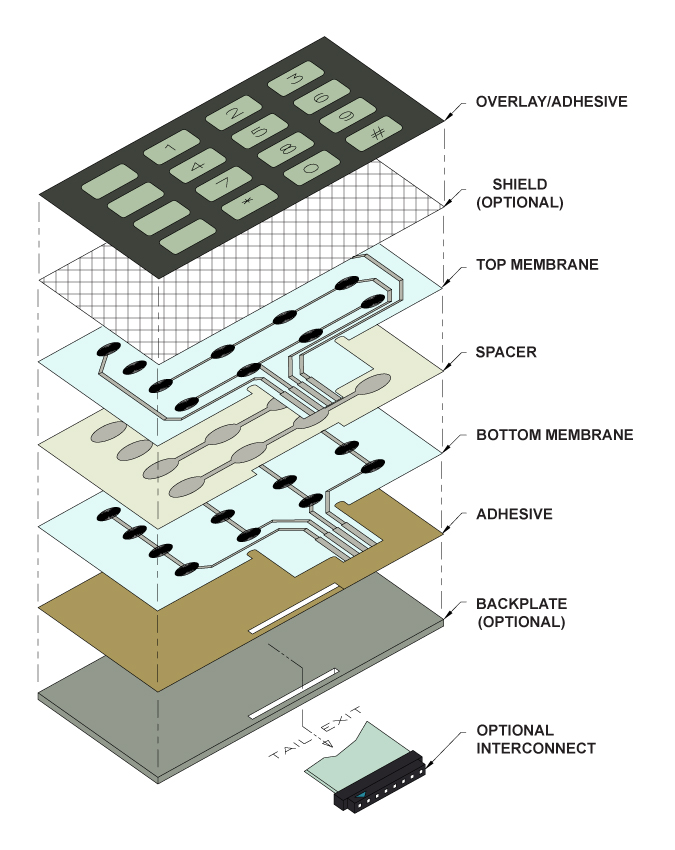Just How a Membrane Switch Enhances Individual Experience and Device Performance
Just How a Membrane Switch Enhances Individual Experience and Device Performance
Blog Article
Recognizing the Functionality of Membrane Switches Over for Individual User Interface Tools
The functionality of membrane layer switches stands for a significant innovation in user interface layout, combining performance with aesthetic flexibility. As markets progressively prioritize user experience, understanding the nuances of membrane button innovation ends up being vital.
What Are Membrane Layer Buttons?
Membrane layer switches are cutting-edge interface gadgets that promote customer communication with digital tools. These functional elements contain multiple layers, including a graphic overlay, spacer, and a published circuit layer. The layout enables for a smooth integration into various electronic tools, improving both the aesthetic and functional elements of interface.
Membrane switches are commonly used in a broad range of applications, from home home appliances to industrial machinery and medical gadgets. Their building commonly features a thin profile, making them an optimal option for compact styles. The responsive feedback given by these switches can be engineered to meet specific user choices, ensuring effective interaction between the customer and the gadget.
Durability is an additional considerable advantage of membrane buttons, as they are immune to dust, wetness, and chemicals, which improves their lifespan sought after environments. In addition, these switches can be personalized in regards to form, dimension, and visuals design, permitting branding and user-specific attributes. Generally, membrane layer switches stand for a practical option for boosting customer experience in electronic tools, combining capability with visual appeal in an effective fashion.
How Membrane Layer Switches Over Job
Operating on a simple concept, membrane switches make use of a layered building to register customer input effectively. Each button consists of several layers, consisting of a printed circuit layer, a spacer layer, and a top visuals layer, which are created to collaborate seamlessly. When an individual presses the leading layer, it compresses the spacer layer, bringing the conductive components of the circuit layer right into contact with each various other.
This get in touch with creates a closed circuit, signaling the device to perform a certain function. The design enables different setups, consisting of responsive comments, which can enhance the user experience by offering a physical experience upon activation. The products made use of in membrane switches usually include flexible substratums, such as polyester or polycarbonate, which guarantee durability and resilience against deterioration.

Key Benefits of Membrane Switches

Another significant advantage is their density. Membrane buttons are thin and lightweight, which allows producers to conserve room in their devices without giving up capability. This attribute is specifically valuable in applications where weight and volume are vital considerations.
In addition, membrane buttons are resistant to dust, dampness, and chemicals, enhancing their toughness. This durability expands their life expectancy and lowers the demand for frequent replacements, leading to expense financial savings in time.
Additionally, the tactile comments supplied by membrane layer switches browse around these guys can be maximized to improve customer communication. They can consist of features such as elevated buttons or audible clicks, improving usability and customer experience.
Applications Across Industries
Interface tools using membrane switches are prevalent in a vast variety of industries, showcasing their adaptability and capability. Membrane Switch. In the clinical market, membrane layer switches are indispensable to devices such as analysis equipment and person tracking systems, where their durability and simplicity of cleaning are important for keeping hygiene standards. In a similar way, in the automobile market, these switches are utilized in dashboard controls and infomercial systems, offering a streamlined and contemporary interface for users.
Moreover, the consumer electronic devices industry benefits from membrane buttons in appliances and handheld gadgets, where portable style and user-friendly user interfaces enhance individual experience. Industrial applications also leverage membrane switches over for control board in machinery and automation systems, emphasizing their effectiveness and resistance to extreme settings.
In the aerospace you could check here and protection markets, membrane layer buttons are utilized in cockpit controls and equipment, where integrity and efficiency under severe problems are critical. Additionally, the gaming industry increasingly includes membrane buttons in controllers and arcade machines, contributing to an interesting user experience. On the whole, the versatility of membrane switches allows their extensive usage across numerous fields, emphasizing their significance in modern-day interface layout.
Future Patterns in Membrane Layer Switch Over Innovation

Additionally, the usage of sophisticated products, such as polycarbonate and polyester movies, is anticipated to climb, giving improved durability and resistance to environmental stressors. These materials add to the general longevity of membrane buttons, making them ideal for harsher commercial applications.
Furthermore, the incorporation of wise innovation, including IoT connectivity, will certainly allow membrane layer switches to communicate with other devices and systems, promoting a much more interactive user experience. This fad lines up with the growing demand for clever gadgets across numerous industries, from healthcare to customer electronic devices.
Finally, modification alternatives are prepared for to broaden, permitting suppliers to create hop over to here bespoke services customized to certain individual demands and preferences. These growths will certainly place membrane buttons as necessary parts in the development of customer interface modern technology.
Verdict
Finally, membrane layer switches represent a crucial development in user interface modern technology, supplying a trusted and flexible service for diverse electronic applications. Their layered building helps with portable layout, while features such as tactile responses improve individual communication. The durability against ecological aspects even more strengthens their energy across multiple industries. As improvements in material science and touch sensing technologies proceed, the functionality and applicability of membrane layer buttons are anticipated to expand, enhancing their significance in contemporary digital tools.
Report this page